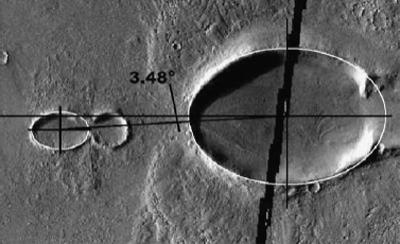On the origin of a double, oblique impact on Mars

J.E. Chappelowa,b,∗, R.R. Herrick b
a Arctic Region Supercomputing Center, University of Alaska Fairbanks, PO Box 756020, Fairbanks, AK 99775-6020, USA
b Geophysical Institute, University of Alaska Fairbanks, PO Box 757320, Fairbanks, AK 99775-7320, USA
a b s t r a c t
A double, oblique impact feature north of Olympus Mons provides a unique opportunity to investigate the
event that formed it. The sizes of the craters, their ellipticity, shapes of ejecta blankets, separation from
each other, and positions relative to each other, all give us information about the event. Coupling this
information with an existing model of meteoritic flight through an atmosphere allows us to test several
possible scenarios for the event (object type and origin, pre-entry trajectory, atmospheric trajectory,
prevailing atmospheric density). We find it highly improbable that the impactor was simply an extramartian
asteroid or comet. We also find that it is unlikely to have been a double-asteroid or a tidally
fractured one, but is more likely to have been a Mars-orbiting moonlet whose orbit tidally decayed, and
that denser atmospheric conditions than today’s may have prevailed when it impacted.
© 2008 Elsevier Inc. All rights reserved.
Article history:
Received 30 January 2008
Revised 14 April 2008
Available online 19 June 2008
The authors have posted an accademic access version of the paper HERE.


